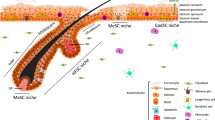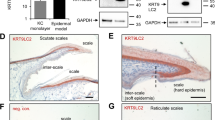Abstract
The epidermis is a stratified squamous epithelium in which keratinocytes progressively undergo terminal differentiation towards the skin surface leading to programmed cell death. In this respect we studied the role of caspases. Here, we show that caspase-14 synthesis in the skin is restricted to differentiating keratinocytes and that caspase-14 processing is associated with terminal epidermal differentiation. The pro-apoptotic executioner caspases-3, -6, and -7 are not activated during epidermal differentiation. Caspase-14 does not participate in apoptotic pathways elicited by treatment of differentiated keratinocytes with various death-inducing stimuli, in contrast to caspase-3. In addition, we show that non-cornifying oral keratinocyte epithelium does not express caspase-14 and that the parakeratotic regions of psoriatic skin lesions contain very low levels of caspase-14 as compared to normal stratum corneum. These observations strongly suggest that caspase-14 is involved in the keratinocyte terminal differentiation program leading to normal skin cornification, while the executioner caspases are not implicated. Cell Death and Differentiation (2000) 7, 1218–1224
Similar content being viewed by others
Log in or create a free account to read this content
Gain free access to this article, as well as selected content from this journal and more on nature.com
or
Abbreviations
- CHX:
-
cycloheximide
- NHK:
-
normal human keratinocytes
- SE:
-
skin equivalent
References
Earnshaw WC, Martins LM and Kaufmann SH . 1999 Mammalian caspases: structure, activation, substrates and functions during apoptosis. Annu. Rev. Biochem. 68: 383–424
Wallach D, Boldin M, Varfolomeev E, Beyaert R, Vandenabeele P and Fiers W . 1997 Cell death induction by receptors of the TNF family: towards a molecular understanding. FEBS Lett. 410: 96–106
Schulze-Osthoff K, Ferrari D, Los M, Wesselborg S and Peter ME . 1998 Apoptosis signaling by death receptors. Eur. J. Biochem. 254: 439–459
Li P, Nijhawan D, Budihardjo I, Srinivasula SM, Ahmad M, Alnemri ES and Wang X . 1997 Cytochrome c and dATP-dependent formation of Apaf-1/caspase-9 complex initiates an apoptotic protease cascade. Cell 91: 479–489
Pan G, O'Rourke K and Dixit VM . 1998 Caspase-9, Bcl-XL, and Apaf-1 form a ternary complex. J. Biol. Chem. 273: 5841–5845
Holbrook KA . 1983 Structure and function of the developing human skin. In Biochemistry and physiology of the skin, Vol. 1, Goldsmith, ed (New York: Oxford University Press) pp. 64–101
Takahashi T, Ogo M and Hibino T . 1998 Partial purification and characterization of two distinct types of caspases from human epidermis. J. Invest. Dermatol. 111: 367–372
Weil M, Raff MC and Braga VM . 1999 Caspase activation in the terminal differentiation of human epidermal keratinocytes. Curr. Biol. 9: 361–364
Van de Craen M, Van Loo G, Pype S, Van Criekinge W, Van den brande I, Molemans F, Fiers W, Declercq W and Vandenabeele P . 1998 Identification of a new caspase homologue: caspase-14. Cell Death Differ. 5: 838–846
Van de Craen M, Vandenabeele P, Declercq W, Van den brande I, Van Loo G, Molemans F, Schotte P, Van Criekinge W, Beyaert R and Fiers W . 1997 Characterization of seven murine caspase family members. FEBS Lett. 403: 61–69
Van de Craen M, Van Loo G, Declercq W, Schotte P, Van den brande I, Mandruzzato S, van der Bruggen P, Fiers W and Vandenabelle P . 1998 Molecular cloning and identification of murine caspase-8. J. Mol. Biol. 284: 1017–1026
Hu S, Snipas SJ, Vincenz C, Salvesen G and Dixit VM . 1998 Caspase-14 is a novel developmentally regulated protease. J. Biol. Chem. 273: 29648–29653
Martins LM, Mesner PW, Kottke PW, Basi GS, Sinha GS, Tung JS, Svingen PA, Madden BJ, Takahashi A, McCormick DJ, Earnshaw WC and Kaufmann SH . 1997 Comparison of caspase activation and subcellular localization in HL-60 and K562 cells undergoing etoposide-induced apoptosis. Blood 90: 4283–4296
Colussi PA, Harvey NL and Kumar S . 1998 Prodomain-dependent nuclear localization of the caspase-2 (Nedd2) precursor. J. Biol. Chem. 273: 24535–24542
Zhivotovsky B, Samali A, Gahm A and Orrenius S . 1999 Caspases: their intracellular localization and translocation during apoptosis. Cell Death Differ. 6: 644–651
Byrne C, Tainsky M and Fuchs E . 1994 Programming gene expression in developing epidermis. Development 120: 2369–2383
Hardy MH . 1992 The secret life of the hair follicle. Trends Genet. 8: 55–61
Poumay Y and Pittelkow MR . 1995 Cell density and culture factors regulate keratinocyte commitment to differentiation and expression of suprabasal K1/K10 keratins. J. Invest. Dermatol. 104: 271–276
Haake A and Polakowska RR . 1995 UV-induced apoptosis in skin equivalents: Inhibition by phorbol ester and Bcl-2 overexpression. Cell Death Differ. 2: 183–193
Ahmad M, Srinivasula SM, Hegde R, Mukattash R, Fernandes-Alnemri T and Alnemri ES . 1998 Identification and characterization of murine caspase-14, a new member of the caspase family. Cancer Res. 15: 5201–5205
Chaturvedi V, Qin J-Z, Denning MF, Choubey D, Diaz MO and Nickoloff BJ . 1999 Apoptosis in proliferating, senescent, and immortalized keratinocytes. J. Biol. Chem. 274: 23358–23367
Lazebnik YA, Kaufmann SH, Desnoyers S, Poirier GG and Earnshaw WC . 1994 Cleavage of poly(ADP-ribose) polymerase by a proteinase with properties like ICE. Nature 371: 346–347
Henseler T . 1997 The genetics of psoriasis. J. Am. Acad. Dermatol. 37: S1–11
Watt FM, Keeble S, Fisher C, Hudson DL, Codd J and Salisbury JR . 1989 Onset of expression of peanut lectin-binding glycoproteins is correlated with stratification of keratinocytes during human epidermal development in vivo and in vitro. J. Cell. Sci. 94: 355–359
Mao PL, Jiang Y, Wee BY and Porter AG . 1998 Activation of caspase-1 in the nucleus requires nuclear translocation of procaspase-1 mediated by its prodomain. J. Biol. Chem. 273: 23621–23624
Sato K . 1993 Biology of the eccrine sweat gland. In Dermatology in General Medicine, Fitzpatrick TB, Eisen AZ, Wolff K, Freedberg IM and Austen KF, eds (New York: McGraw-Hill) pp. 221–241
Schön M, Benwood J, O'Connell-Willstaed T and Rheinwald JG . 1999 Human sweat gland myoepithelial cells express a unique set of cytokeratins and reveal the potential for alternative epithelial and mesenchymal differentiation states in culture. J. Cell Sci. 112: 1925–1936
Seitz CS, Freiberg RA, Hinata K and Khavari PA . 2000 NF-κB determines localization and features of cell death in epidermis. The J. Clin. Invest. 105: 253–260
Zhou Q and Salvesen GS . 1997 Activation of pro-caspase-7 by serine proteases includes a non-canonical specificity. Biochem. J. 324: 361–364
Schotte P, Van Criekinge W, Van de Craen M, Van Loo G, Desmedt M, Grooten J, Cornelissen M, De Ridder L, Vandekerckhove J, Fiers W, Vandenabeele P and Beyaert R . 1998 Cathepsin B-mediated activation of the proinflammatory caspase-11. Biochem. Biophys. Res. Commun. 251: 379–387
Green H . 1977 Terminal differentiation of cultured human epidermal cells. Cell 11: 405–416
Ragaz A and Ackerman AB . 1979 Evolution, maturation, and regression of lesions of psoriasis. New observations and correlation of clinical and histologic findings. Am. J. Dermatopathol. 1: 199–214
Bata-Csorgo Z, Hammerberg C, Voorhees JJ and Cooper KD . 1993 Flow cytometric identification of proliferative subpopulations within normal human epidermis and the localization of the primary hyperproliferative population in psoriasis. J. Exp. Med. 178: 1271–1281
Bos JD and De Rie MA . 1999 The pathogenesis of psoriasis: immunological facts and speculations. Immunol. Today 20: 40–46
Boukamp P, Petrussevska RT, Breitkreuz D, Hornung J, Markham A and Fusenig NE . 1988 Normal keratinization in a spontaneously immortalized aneuploid human keratinocyte cell line. J. Cell Biol. 106: 761–771
Kitano Y and Okada N . 1983 Separation of the epidermal sheet by dispase. Br. J. Dermatol. 108: 555–560
Van de Craen M, Declercq W, Van den brande I, Fiers W and Vandenabeele P . 1999 The proteolytic procaspase activation network: an in vitro analysis. Cell Death Differ. 6: 1117–1124
Dewulf N, Verschueren K, Lonnoy O, Moren A, Grimsby S, Vande Spiegle K, Miyazono K, Huylebroeck D and ten Dijke P . 1995 Distinct spatial and temporal expression patterns of two type I receptors for bone morphogenetic proteins during mouse embryogenesis. Endocrinology 136: 2652–2663
Acknowledgements
The authors wish to thank E van Damme and M De Bie for technical assistance, W Drijvers and M Vandecasteele for editorial help, and A Raeymaekers for recombinant cytokine purification. P Vandenabeele is a Research Associate and M Kockx is a post-doctoral Research Assistant with the FWO-Vlaanderen. Research was supported by grants of the Interuniversitaire Attractiepolen (contract nr. P4/26), and EC-RTD program (QLRT-199-00739) and a grant of the Fonds voor Wetenschappelijk Onderzoek-Vlaanderen (No. 9005097N).
Author information
Authors and Affiliations
Corresponding author
Additional information
Edited by G Melino
Rights and permissions
About this article
Cite this article
Lippens, S., Kockx, M., Knaapen, M. et al. Epidermal differentiation does not involve the pro-apoptotic executioner caspases, but is associated with caspase-14 induction and processing. Cell Death Differ 7, 1218–1224 (2000). https://doi.org/10.1038/sj.cdd.4400785
Received:
Accepted:
Published:
Issue date:
DOI: https://doi.org/10.1038/sj.cdd.4400785
Keywords
This article is cited by
-
Comparative genomics of monotremes provides insights into the early evolution of mammalian epidermal differentiation genes
Scientific Reports (2024)
-
Caspases in Alzheimer’s Disease: Mechanism of Activation, Role, and Potential Treatment
Molecular Neurobiology (2023)
-
Extracellular epimorphin impairs expression and processing of profilaggrin in HaCaT keratinocytes
Cytotechnology (2023)
-
A Review on Caspases: Key Regulators of Biological Activities and Apoptosis
Molecular Neurobiology (2023)
-
The ion balance of Shotokuseki extract promotes filaggrin fragmentation and increases amino acid production and pyrrolidone carboxylic acid content in three-dimensional cultured human epidermis
Natural Products and Bioprospecting (2022)



